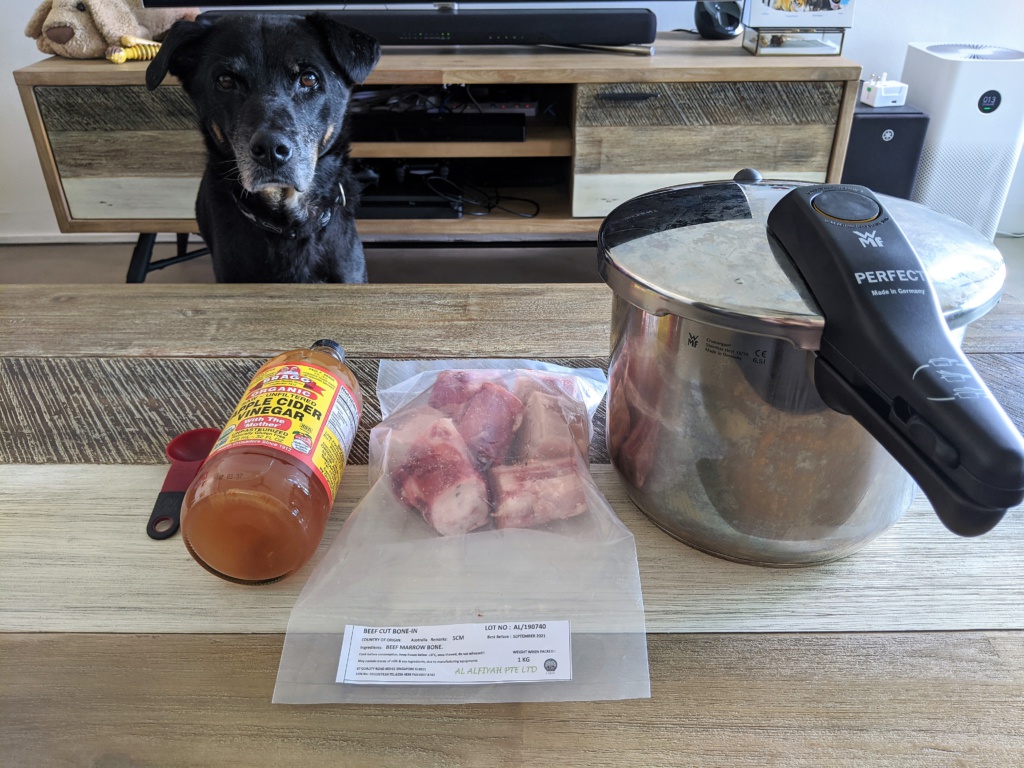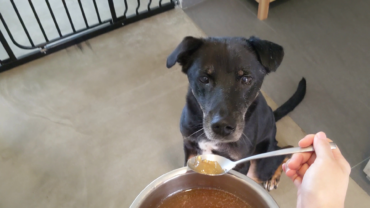There are many benefits of bone broth for both humans and dogs! It makes a great addition to your dog’s diet and helps with joint aches, digestion, healthy gut etc. Simply search online and you will find a list of benefits.I have tried using a variety of different types of bone – pork, beef and lamb (did not try chicken since Bam Bam is allergic). I recommend using marrow bones or joint bones with cartilage as they contain a significant amount of collagen that gives you a gel-like consistency. I get lamb bones from the neighbourhood market at $6/kg, pork bones from Sheng Shiong at $7-$8/kg and beef bones from S.S.KIM at $4.50/kg or OMNI at $2.57/kg . I find bones with little to no meat take a shorter period of time and will yield more since there will be lesser fat.
What you need:
- 2 kg of bones
- 3 tbsp apple cider vinegar (ACV) – I had more success in achieving a gel-like consistency using Bragg’s ACV as compared to HEINZ
- 3 L water (approximately)
- A dog to taste test

Method:
- Place 2 kg of bones inside the pressure cooker.
- Add in 3 tbsp ACV and approximately 3 litres of water. A good gauge would be to ensure that the bones are fully covered with water or until it reaches the maximum capacity of the pressure cooker.
- Place it on high heat and cover with the lid.
- When the pressure has reached its max, lower the heat and let it boil for 8 – 9 hours. I use an induction cooker with a heat range of 1 – 9 and usually leave it on at level 4.
- After boiling, strain the bone broth and leave it to cool. Put it in the fridge overnight to allow the layer of fat to form at the top. This makes it easier to remove it the next day.
Tips/things to note:
- I used to defrost the frozen bones before boiling but I find that it did not make a difference if I used the frozen ones immediately.
- After boiling the broth on high heat for 5 mins, I would also skim off the scums before covering it with the lid. Again, not much of a difference when I skipped this.
- It took me a few tries to get the duration right to achieve a gel-like consistency. Do not fret if you are unsuccessful the first few attempts. The following factors may play a part:
- Types of bone used – joint bones contain a high level of collagen. Gelatin is the cooked form of collagen which gives you that gel-like consistency. I have tried using normal soup bones and was unsuccessful.
- Amount of ACV – the acidity helps to extract the collagen.
- Duration – You may need to boil the broth longer to extract the collagen out from the bones.
- Gelling happens when you cool it down in the fridge. If you put it out at room temperature, you will start to see it ‘melting’ into a liquid form which is normal. Bone broth is still nutritious even if it does not gel after refrigeration! Gelling is just a sign that it contains more collagen. I found this article useful in understanding why my bone broth was not having that gel-like consistency: Troubleshooting Bone Broth: Why Won’t It Gel?
- Also, please remember to watch the cooker when it is on high heat. Once, I completely forgot about it and by the time I heard the noise, it was too late, and my pressure cooker was spurting broth and it flooded the countertop and floor! There was bone broth all over the wall as well, ABSOLUTE NIGHTMARE!
- You can also add in vegetables in your bone broth. I tried adding carrots and spinach once and the results were the same.
- As homemade broths do not contain preservatives, it can sit in the fridge for only 3 – 4 days. Pack it in several containers and freeze it. You can also freeze it in big ice cube trays and defrost it before consumption.
- If you do not have a pressure cooker, you can use a slow cooker but do note that it will take much longer (possibly 18 – 72 hours).
Enjoy and have fun making bone broths for your puppers! I have yet to add it in my daily diet but I came across a bone broth recipe that said “Better than Botox”. Time to reconsider!
